Rudderless rebellion: Inside HK protesters' anarchic campaign against China
Ah Lung spends his days working as a clerk for a Hong Kong shipping firm. At night, he dons a mask, black helmet and body armour, and heads out into the streets to face off against the city's riot police.
The 25-year-old activist has been a constant presence at the often violent protests that have rocked Hong Kong this summer, rallying comrades, building barricades and rushing from district to district in a frantic game of cat-and-mouse with police.
Ah Lung, who would only identify himself by his nickname, which means "dragon" in Cantonese, is representative of a growing number of discontented young Hong Kongers who are fuelling a protest movement that, unlike its predecessors, is taking aim directly at Beijing.
It is a movement without clearly discernible leaders or structure, making it difficult for the authorities to effectively target - and increasingly hard for the protesters themselves to manage.
While it has the support of established pro-democracy groups, the amorphous movement is fuelled by activists like Ah Lung - young Hong Kongers who operate independently or in small groups and adapt their tactics on the run.
"We're not so organised," Ah Lung said. "Every day changes, and we see what the police and the government do, then we take action."
"My dream is to revive Hong Kong, to bring a revolution in our time," Ah Lung said. "This is the meaning of my life now."
Through interviews with dozens of protesters like Ah Lung and reporting from dozens of protests, Reuters has pieced together a picture of how this movement functions and the mindset driving it.
'Free Hong Kong'
The protests, which started as a peaceful rebuke of the Hong Kong government back in April, have evolved into a direct challenge to Communist Party rule over this former British colony.
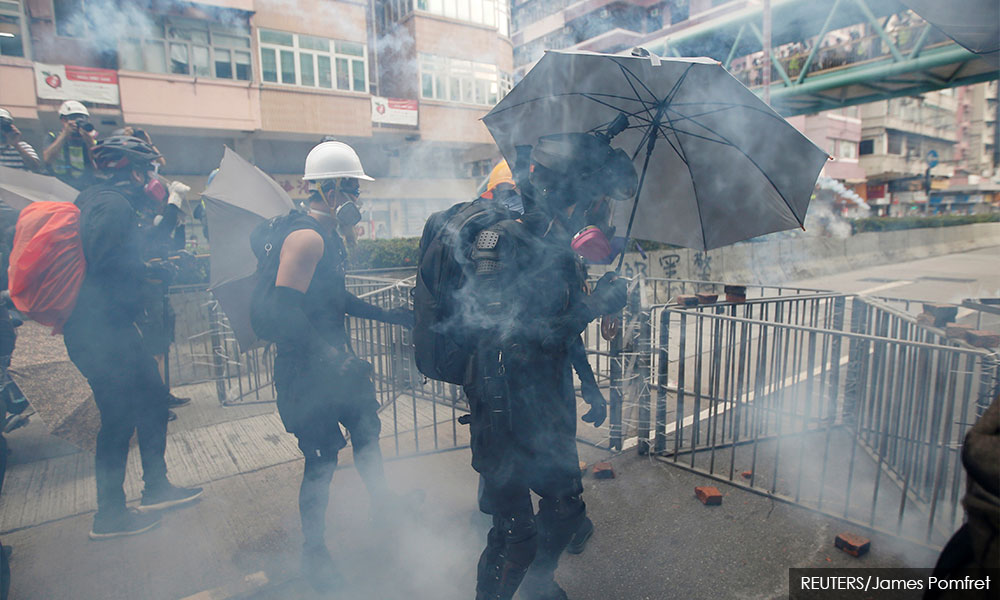
With slogans such as "Free Hong Kong" and "Hong Kong is not China," Ah Lung and his fellow protesters have made clear they reject a future in which Hong Kong is inexorably absorbed into the mainland giant, eventually becoming just another Chinese city.
Protesters are provocatively calling the demonstrations an "era of revolution," a formulation that has infuriated a ruling Chinese Communist Party determined to crush any challenge to its monopoly on power.
Scenes once unthinkable in Hong Kong are now commonplace: The city's international airport being shut down this week after a prolonged occupation by protesters; a Chinese official publicly suggesting that aspects of some of the protests were terrorism; the legislature stormed and ransacked by protesters; police officers repeatedly baton-charging crowds of protesters and unleashing torrents of tear gas in famed shopping districts.
On Tuesday, protesters who managed to shut down the airport also attacked a Chinese man for being a suspected undercover agent. He was identified as a reporter for the Global Times, a tabloid controlled by Beijing, highlighting how activists are making the Chinese government the target of their protests.
It also brought another issue into focus: the risks of waging a leaderless rebellion. Demonstrators later apologised for the disruptions at the airport, apparently concerned that their chaotic protests might alienate broader sections of the Hong Kong public who had been supporting them.
"The movement has a large degree of self-restraint and solidarity, but of course that's very conditional," said Samson Yuen, a political scientist at Lingnan University in Hong Kong who has conducted surveys of protesters to understand their motives and support base.
"If certain actions spin out of control, if say someone dies from it, then that might be a game-changer."
One country, two systems
Under the "one-country, two-systems" formula, China promised Hong Kong it would enjoy autonomy for 50 years after its handover from Britain in 1997.
Unlike those who negotiated the deal, for young protesters born after the handover that deadline will fall in the middle of their lives. And, as Beijing tightens its grip on Hong Kong, the future they see careening towards them is that of an authoritarian mainland China with curbs on the freedoms and rights they now enjoy.
"In 2047, if it returns to China, real Hong Kongers will leave and emigrate from Hong Kong," said Ah Lung, speaking in a small apartment in the Sham Shui Po neighbourhood as he prepared for a night of protests that quickly descended into violence.
"By then, it won't be Hong Kong anymore, but Xiang Gang," he said, referring to the name commonly used on the mainland for Hong Kong.
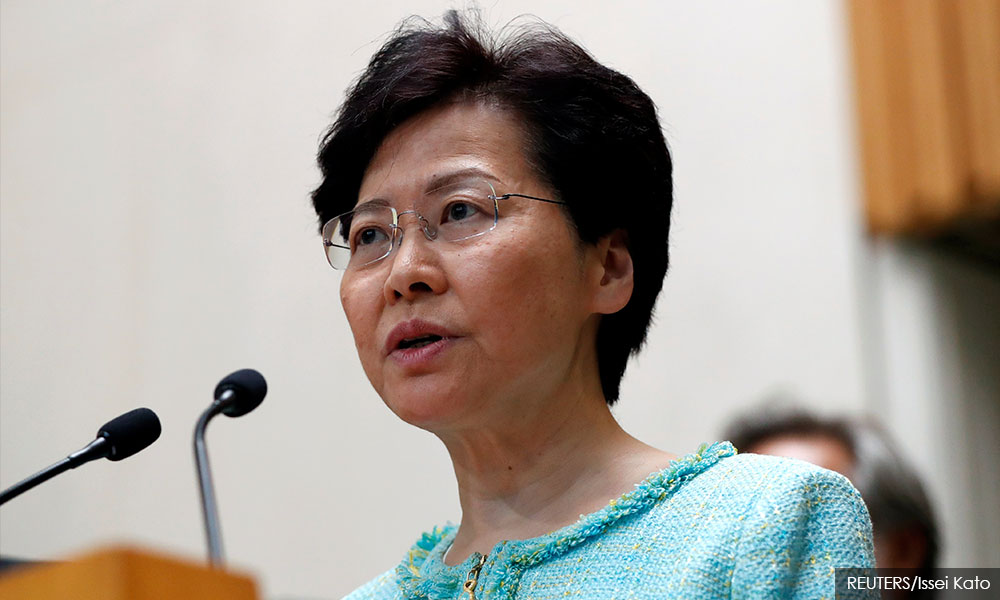
Hong Kong Chief Executive Carrie Lam has said that protesters' calls for a revolution to "liberate" Hong Kong are illegal acts that challenge the authority of the central government in Beijing.
In response to questions from Reuters about the protests, a spokesman for Lam referred to her promise to address income disparities in the city once the violence subsides.
The Hong Kong Liaison Office, Beijing's main representative arm in the city, and the Chinese Foreign Ministry did not respond to questions from Reuters.
The Hong Kong police did not respond to questions from Reuters. During the protests, police spokesmen have repeatedly defended the use of force and have pointed to escalating violence by protesters that has included throwing bricks and fire bombs.
Leaderless movement
The protesters' mantra – "Be water!" – epitomizes the movement's tactics. A phrase borrowed from the Hong Kong movie star Bruce Lee, who used it to describe his kung fu philosophy, it is a call for flexibility and creativity, moving forward to press an advantage and pulling back when a strategic retreat is needed.
Its latest manifestation is the series of wildcat protests that have spread across the city in recent weeks. When police turn up in numbers at one protest, the activists often engage them, tying down officers before melting away and reappearing to stage a fresh protest in another area.
Pro-democracy protests that paralysed much of downtown Hong Kong in 2014 involved blocking several key roads for more than two months. The more fluid tactics now being deployed by protesters, often masked to avoid surveillance and dressed in black, present a greater challenge for the police. Frontline officers speak of exhaustion, saying they never know where the activists will strike next.
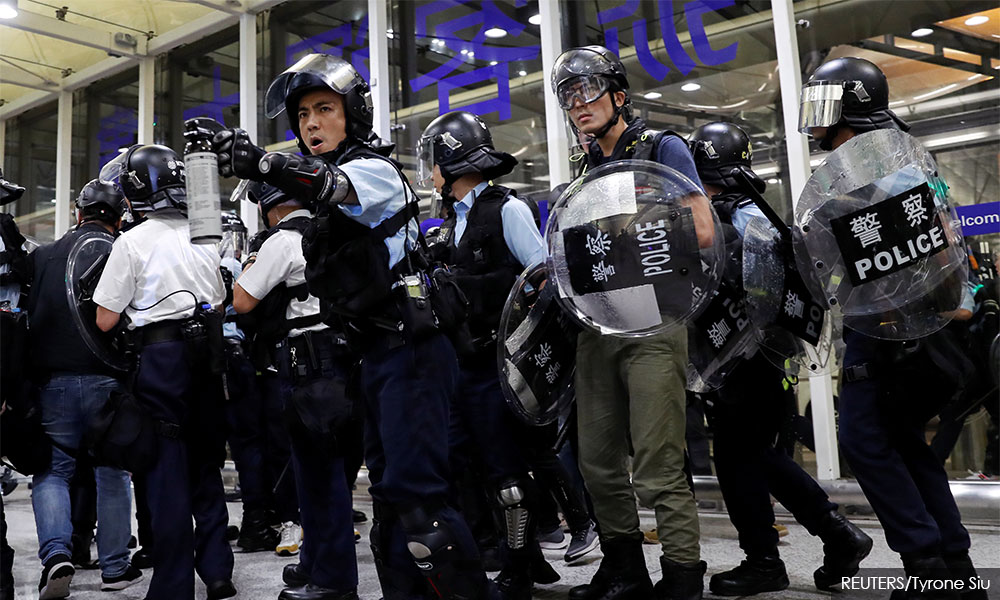
Protesters say their movement is leaderless. In some ways, that's a reaction to the 2014 demonstrations in which many of the leaders were arrested and given prison terms.
Unlike those protests, when leaders like Joshua Wong became globally recognised names, frontline activists like Ah Lung are deliberately staying under the radar, using pseudonyms and appearing at protests with their faces obscured by masks and sunglasses.
The leaderless nature of the protest movement is made possible, to a large extent, by social media.
Protesters take their cues from more than 100 groups on the instant messaging app Telegram, dozens of Instagram sites and online forums like LIHKG. The groups are used to post everything from news on upcoming protests to tips on dousing tear gas canisters fired by the police to the identities of suspected undercover police and the access codes to buildings in Hong Kong where protesters can hide.
It's not an issue of having "no leader, it simply means that everyone is a leader," said one 22-year-old Hong Kong student based in Britain who helps run "antielabhk," an Instagram page that includes details about protests that has amassed more than 50,000 followers. The student asked not to be named.
Ma, a 28-year-old university student who would only give her surname, said at a recent protest in the volatile Mongkok district that she had come after seeing recruitment appeals in a Telegram group. "We were only notified or briefed today – like an hour ago," said Ma, as she handed out water to protesters.
The front lines
A feature of the protests in recent weeks has been the sight of ordinary activists like Ah Lung, the shipping clerk, rallying other protesters.
In Sham Shui Po on Sunday, Ah Lung joined other masked "frontliners" as the protest began. Some used wrenches to loosen bolts on roadside fences, which were then shaken loose, bound with nylon ties, and formed into makeshift barricades against the police.
Ah Lung, brandishing a Star Wars light sabre he had bought at a toy shop, called out instructions on where to position the barricades. As they worked, other masked protesters used hand-held telescopes to track police movements.
The improvised, bottom-up nature of the protest movement is further evident in the scores of medics, some of them medical staff from local hospitals, who say they have turned up unprompted at protest sites to treat the wounded and administer saline solution to tear gas victims.
Kay, a 28-year-old medic who works in information technology and would only give her first name, said she prepared an emergency kit, including iodine, bandages, tourniquets and saline solution before every protest.
"I was hit by a tear gas canister one time and then when I retreated to a safe spot, some people helped me. I felt touched, and I wanted to help some people back."
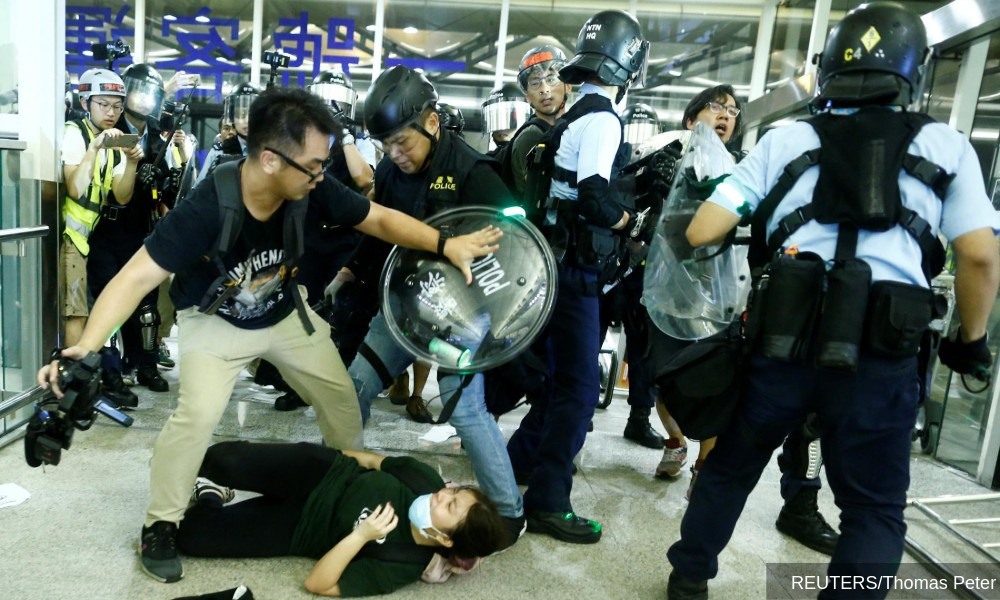
While the protest movement may not have clearly identifiable leaders, it does have the backing of prominent pro-democracy activists and groups who have organised some of the demonstrations. In the past, they have led smaller, more orderly demonstrations that were not aimed so pointedly at the leadership in Beijing.
Reuters reporting shows there is a high degree of coordination among a small circle of these activists, many of whom participated in the 2014 protests that were sparked by Beijing's refusal to grant Hong Kong universal suffrage.
For instance, members of Demosisto, a party that advocates for greater democracy in Hong Kong, have been behind a number of demonstrations, some of which ended in violent clashes with riot police, according to the group's members.
Last month, Tobias Leung, a member of the party's standing committee, applied for police permission to stage a rally in the suburban district of Sha Tin. Leung's link to the protest wasn't immediately clear because he applied under the name of a local community group, according to Wong, the leader of Demosisto.
Wong and other prominent activists have been present at various demonstrations, sometimes close to the front lines. But they have struggled to impose leadership on the streets, with the protesters debating amongst themselves and consulting their phone groups on what action to take.
Along with other prominent democrats in the city, Wong has been seen at protests by Reuters being shouted down by activists who say they don't want the movement hijacked by any single leader or group.
"I'm quite happy people are saying we should not rely on any specific political leader to lead this movement," Wong told Reuters.
Jailed independence activist Edward Leung, who is revered by many of the protesters, is currently serving a six-year sentence for rioting stemming from a protest in 2016.
Francis Lee, a professor at the Chinese University of Hong Kong, who has written a book on Hong Kong social movements, describes the protests as an "open source" movement. Protesters often aggregate the best ideas in online groups and vote on courses of action, he said.
China has accused foreign countries of being behind the protests. Both Western and Asian diplomats in the city monitor the protests closely and some have been seen at events. Diplomats say this is part of their routine work.
Frustrations boil over
The protests erupted in late April over a bill proposed by Lam that would have allowed the extradition of defendants from Hong Kong to mainland China. Unlike the demand for universal suffrage, which fuelled the 2014 protests, the extradition bill was seen as a specific, tangible threat by many Hong Kongers, galvanizing hundreds of thousands of people.
Facing huge protests, Lam announced on June 15 that she was freezing the bill.
That wasn't enough for many Hong Kong residents, many of whom flooded onto the streets in one of the largest protest marches ever seen in the city, largely organised by a coalition of civil society groups. The march brought together a diverse cross-section of Hong Kong society, including members of the city's politically conservative middle class.
A major turning point in the protests was an assault on July 21 on Beijing's Central Government Liaison Office – the most prominent symbol of China's authority in Hong Kong.
Black-clad activists arrived at dusk at the glass-steel skyscraper that bears the red state seal of China above its entrance. As the crowd quickly swelled to thousands, some protesters hurled eggs at the building. Others used spray paint to scrawl the words "Revolution of Our Time" on the walls.
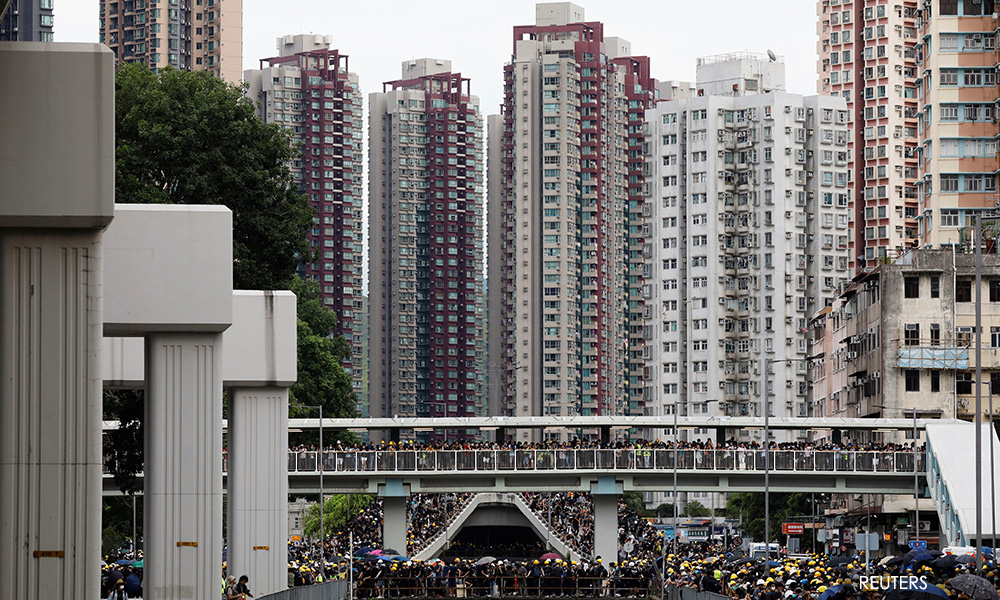
Some tried to neutralise surveillance cameras by targeting them with laser pointers. To roars of approval, protesters then lobbed black paint at the state seal of China.
"Carrie Lam has refused to listen to our concerns about Communist Party interference," said one 27-year-old protester who would only give his name as Paul, as he attached vials of anti-tear gas fluid onto his military-style backpack. "Now we have to send our message to the communists directly."
The Liaison Office has since become the target of repeated protests.
Nick Tsang, a protester clad in a black balaclava and black clothes, was in a crowd that began congregating in a Hong Kong park on the afternoon of July 28.
Tsang checked out a Telegram group to see where other protesters were going. One group of protesters splintered off and headed to the city's police headquarters, while another group branched out in the direction of the Causeway Bay shopping district. Later on, some backtracked towards the Liaison Office. Tsang followed them.
This time, the building was fortified with water-filled plastic barriers, and several battalions of riot police and other elite units. Liaison Office staff, meanwhile, had replaced the sullied state seal with a new one and encased it in a plexiglass box.
Following several hours of heated clashes in the streets around the Liaison Office, a rearguard of protesters, including Tsang, found themselves surrounded by police. With tear gas swirling, they made a run for the Hong Kong subway system and escaped onto a train.
"We can't retreat or the authoritarianism will worsen," said Tsang, referring to the Chinese government.
"This is not about me. This is for Hong Kong, my home city."
- Reuters
RM12.50 / month
- Unlimited access to award-winning journalism
- Comment and share your opinions on all our articles
- Gift interesting stories to your friends
- Tax deductable
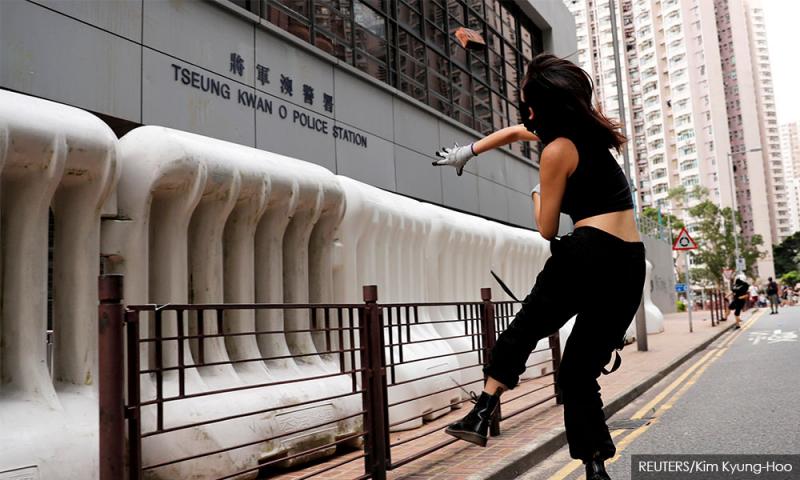
 Reuters
Reuters